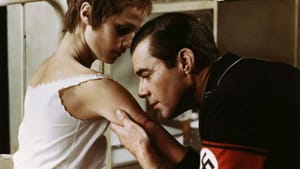Stay in the Loop
BSR publishes on a weekly schedule, with an email newsletter every Wednesday and Thursday morning. There’s no paywall, and subscribing is always free.
Seduced and deceived: Can we talk, please, about women and Nazis?
‘Hannah Arendt’: A gender issue (follow-up)

Last July, Dan Rottenberg, Gresham Riley, Robert Zaller, and I engaged in a dialogue about Margarethe von Trotta’s controversial film, Hannah Arendt. Our writing concerned the trial of Adolf Eichmann, a key architect of the Holocaust, and Arendt’s unintentionally inflammatory New Yorker articles and book about “the banality of evil.” (The dialogue begins here.)
Recently, Ruth Perlmutter, artistic director emerita of the Philadelphia Jewish Film Festival, invited us to be panelists for a screening of the film at the William Penn House near Rittenhouse Square. Gresham and Robert were otherwise committed, so on January 23, Dan and I did the honors.
The film and the discussion prompted me to write further — this time more about the film and Arendt than the Eichmann trial per se. I was puzzled by apparent misperceptions attributable to both Arendt and von Trotta, two brilliant women from whom one would not expect such slips of mind.
I found myself inwardly musing obsessively about these two women. Just what drove them — in the one case, to write, and the other to make a film— in just the way they did?
Seduced by Heidegger
My preoccupation was triggered in part by a fascinating review of the film in The Nation (Nov. 19, 2013) in which David Rieff contended that the movie is peppered with factual errors and distortions. He pointed out that von Trotta and her co-script writer Pam Katz distorted the roles of such figures as Kurt Blumenfeld, Hans Jonas, and Siegfried Moses. For example, the film confabulates two characters: the Zionist leader Kurt Blumenfeld and the Kabalistic scholar Gershom Scholem. Rieff held that it was Scholem — not Arendt’s dear friend Blumenfeld — who questioned her theory of the “banality of evil.” Putting Blumenfeld in his place in the film over-sentimentalized the situation and placed Arendt too much in the role of a victim, as did other distortions in the film. Why would a director making a serious docudrama alter the facts about such historically important persons and events?
Then too, Arendt’s love affair with the philosopher Martin Heidegger, which I mentioned in my original article as the reason for my interest in the film, continued to play on my mind. Why would an ardent Arendt (note the anagram), a passionate opponent of totalitarianism, have engaged in a love affair with her professor, a man who would later embrace Nazism? To quote Freud — at the risk of offending some feminists — “What does a woman want?” And does this question bear at all on the problem of the “banality of evil”?
Two-dimensional men
The film — even its matter-of-fact title Hannah Arendt — seduces the viewer to take it literally as fact. Von Trotta’s directorial approach is pseudo-realistic. The characters are presented in a literal manner, without depth analysis, not unlike an “on the scene” documentary. We are taken into the rooms of the protagonists but not their minds. We learn little or nothing about Arendt’s inner life or Eichmann’s underlying character structure.
It’s indeed ironic that all the men in the film are, to use Arendt’s term, “banal.” Whether it is Arendt’s husband Heinrich, the New Yorker editor William Shawn, or Arendt’s friend, the brilliant thinker Hans Jonas, all come across as reasonable men of unquestionably good intentions. (Conversely, Arendt’s severest critics are portrayed almost as gangsters.) None of them displays the flesh and bones of vulnerable, fallible men driven by conflicting motives. Instead, von Trotta’s men are “good guys” and “bad guys,” either supportive or critical of Arendt but lacking the inner depth of real men. The film itself is a postmodern opposite to the surreal unconscious depth-probes of Bergman, Cavani, Fellini, and Antonioni, for example.
The film’s flatness is intended. Indeed, it’s what makes the film successful. We feel we have directly witnessed the events as they occurred. The whole film takes on the “instant replay” aspect of the Eichmann trial videos themselves.
Arendt’s blindness
But in retrospect, such feigned realism renders the film’s factual distortions puzzling and egregious. Since we get no psychological insight into the men in the film, how are we to acquire awareness of the “inner” Eichmann — something that Arendt felt she captured in her term “banal”?
Similarly, Barbara Sukowa’s portrayal of Arendt bypasses in all but the most superficial ways her inner struggles with her Jewish heritage and her brief internment in a concentration camp, her subconscious reasons for going to Jerusalem and covering the trial, and, most sharply, her affair with Heidegger, one of the most — if not the most — influential figures in Arendt’s life. (He makes little more than a cameo appearance in the film.) Although Arendt knew and wrote about many brilliant men, such as Karl Jaspers and Walter Benjamin, she became a mistress to Heidegger, an older married man, who, while not then a Nazi, was autocratic and sometimes outright cruel to his academic associates. Did the same blindness to Arendt’s revered professor’s malevolent side lead her decades later to reduce Eichmann’s malevolence to bureaucratic banality?
Another Nazi in hiding
Von Trotta’s and Arendt’s banal assessments of men stand in sharp contrast to Liliana Cavani’s treatment of a Nazi-in-hiding in The Night Porter (1974). Like Eichmann, the ex-Nazi Max (played by Dirk Bogarde), works blandly at a mundane job to hide his identity. But Max is far from banal: His façade conceals unmistakable deceptiveness, eroticism, and sadism, all manifest in his affair with his former concentration camp inmate, Lucia (Charlotte Rampling), who shows up at the hotel where Max dissimulates as a servant-figure.
Cavani not only exposes Max’s ruthlessness, but she also insightfully suggests its seductive appeal not only to Lucia, but to women in general, with romantic music, exciting sex scenes, and a very handsome and suave actor as the Nazi. Could it be that both von Trotta and Arendt shared a degree of Lucia’s trauma-based attraction to sadistic men, leading them both to deny the evil sadism in Eichmann and other men?
Men’s dark side
A kind of color-blindness to men’s evil intent does provide a tentative explanation why both of these women would short-circuit the complexity of men, and in particular for Arendt to attribute an “absence of malice” to Eichmann, an active Nazi and security officer from the very beginning. How could Arendt have portrayed this malevolent individual as a banal bureaucrat unless she was fooled by his bland exterior at the trial, which occurred after he had 15 years to practice dissimulating and concealing his real identity?
I offer this view of von Trotta’s and Arendt’s possible blindness to men’s dark side not as a criticism of either woman but to suggest that the most gifted and brilliant people among us can be deceived by their own unconscious motives into distorting the very truth they so profoundly and ardently seek. Arendt’s thesis on the “banality of evil” does indeed possess great merit. I just wonder if she chose a good example in Eichmann.
To my surprise, the discussion at the William Penn House was largely balanced and reflective. I had expected the audience would be contentious in supporting or opposing Arendt’s theory of the “banality of evil.” Instead, those in our audience thoughtfully weighed in on the issues and expressed compassion for both Arendt and the many Jews who felt she betrayed the victims of the Holocaust by dismissing Eichmann as “banal.” Thus the audience didn’t repeat the past but reflected empathically upon it. My participation made me aware that community dialogue is a natural extension of contributor writings in BSR. So I add my vote to those who have suggested we have more such events.
Sign up for our newsletter
All of the week's new articles, all in one place. Sign up for the free weekly BSR newsletters, and don't miss a conversation.

 Victor L. Schermer
Victor L. Schermer